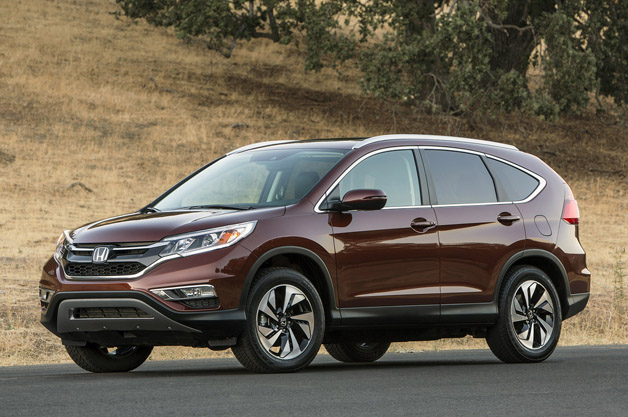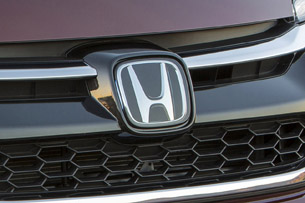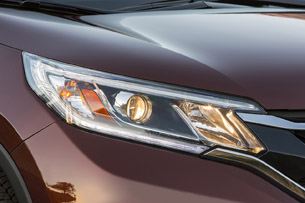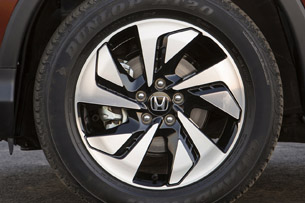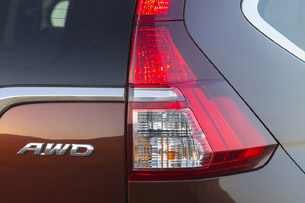would have been difficult based on the Civic-derived model that first
arrived on our shores for the 1997 model year. The newcomer, selling
alongside the body-on-frame Passport (a hastily rebadged
),
was a cute compact crossover with four doors and an awkward curb-side
hinged tailgate thanks to its Japanese home-market design. The
five-passenger CUV offered generous interior room, but its wheezy
2.0-liter four-cylinder, with an output of just 126 horsepower and 133
pound-feet of torque, required 11.7 seconds to bring the 3,153-pound
vehicle to 60 miles per hour. Rear drum brakes didn’t help much in the
stopping department, but
offered safety-minded consumers optional anti-lock brakes on the premium trim.
Nearly two decades after its introduction, the CR-V has matured in
spectacular manner. The refreshed 2015 Honda CR-V, now in its fourth
generation, is dimensionally within two inches of its ancestor in
overall length and nearly identical in height and wheelbase. That
consistency of dimension is impressive in this age of size and segment
creep, and it stands as a testament to how ‘right’ Honda engineers got
the model’s original packaging. Of course, the CR-V hasn’t stood still –
nearly everything else about the best-selling compact CUV has improved
in leaps and bounds.
But Honda is not the only player in this hotly contested segment
today, so the automaker has taken the unusual step of updating its
fourth-generation model just a few years after its introduction in an
effort to keep it seated on the podium. To learn more about the
automaker’s improvements, and form our own impressions, we spent a day
driving the CR-V in sunny Southern California.
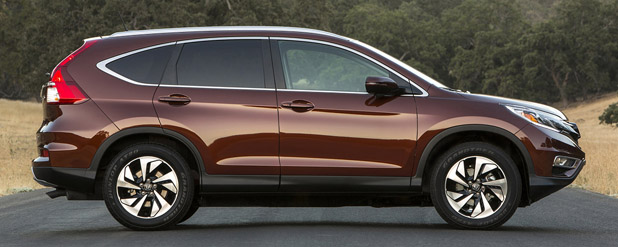
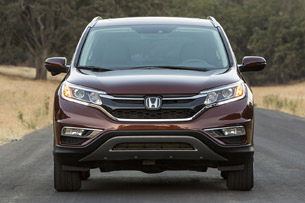
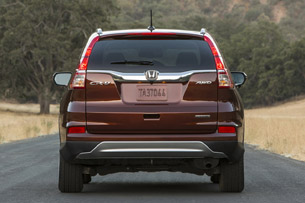
The 2015 CR-V has a new look inside and out, a new powertrain, new technology and new features. This is a big deal.
Ask Honda folks whether they consider the 2015 CR-V to be “refreshed”
or simply “updated,” and they will tell you the makeover is internally
called a “minor model change.” A moment later, they will further explain
that many more things happened to the crossover than usual for such
exercises, so the transformation is actually a “major minor model
change.” Yet they contradict themselves in the press release, where it
is termed a “mid-model cycle redesign.” Whatever terminology the company
uses, there’s one thing we do know: the 2015 CR-V has a new look inside
and out, a new powertrain, new technology and new features – this is a
big deal.
The refreshed (that’s the term we are sticking with) compact
crossover has a pretty new face that is brighter and more uplifting, a
result of a new front grille, available LED running lights, plenty of
additional chrome and styling that ties all of the elements together
very cohesively. The sides are defined by new wheel packages, with
redesigned 17- and 18-inch alloys. The front looks good, but we are less
impressed with the rear, as the new bright chrome bar at the base of
the rear window and a thick brushed aluminum lower fascia make its
tailgate appear heavy and cumbersome. Thankfully, the automaker has
retained the CR-V’s attractive signature reverse and brake lights, which
are mounted high on the roof pillar to keep them cleaner and improve
visibility.
Inside the five-place cabin, occupants will note improved textures
and materials throughout – think premium. The center console armrest is
now standard, as are telescoping sun visors that slide to cover the
length of the side windows and rear-console ventilation ducts. Honda’s
new seven-inch capacitive touchscreen Display Audio telematics interface
is also a new offering, which can be bundled with the next-generation
of Honda Link, the automaker’s web-based infotainment interface.
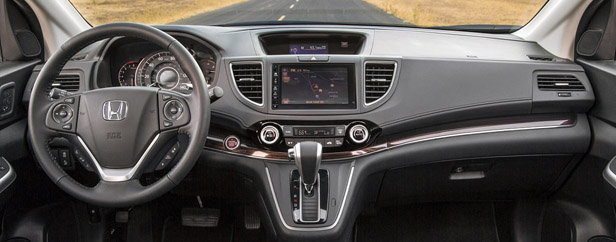
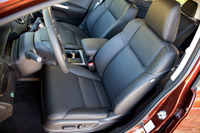
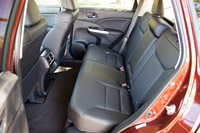
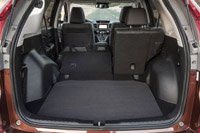
Horsepower is
identical at 185, but torque jumps from 163 pound-feet to 181
pound-feet, improving both responsiveness and acceleration.
There are dozens of improvements to the refreshed CR-V, but don’t
think that the changes are all tactile or purely cosmetic. According to
Honda, its next-generation Advanced Compatibility Engineering (ACE) body
structure received over 60 alterations to improve chassis stiffness and
collision performance – the ride is improved and the 2015 CR-V is
expected to earn a Top Safety Pick+ rating from the Insurance Institute
of Highway Safety (testing commences next month, with results likely
announced in December).
The most important news is found under the hood, where Honda has replaced last year’s 2.4-liter four-cylinder with its
Earth Dreams 2.4-liter engine, a newer powerplant already found under the hood of the
Accord.
While the displacement may be identical, the new engine features direct
injection, a forged-steel crankshaft and a pair of chain-driven,
counter-rotating balance shafts that offset the four-cylinder engine’s
typical harmonic vibrations, allowing it to run smoother. Horsepower is
identical (carried forward at 185), but torque jumps from 163 pound-feet
to 181 pound-feet, improving both responsiveness and acceleration.
In years past, the engine was mated to a five-speed automatic
transmission, but the crossover is singing a new tune with the
introduction of a continuously variable transmission (CVT), which is
lighter and more compact than the automatic gearbox it replaces. It
addition to offering unsurpassed smoothness, it has a 33-percent wider
overall ratio spread than the outgoing five-speed to improve efficiency
and drivability. As has always been the case, buyers are offered a
choice between front-wheel drive and all-wheel drive.
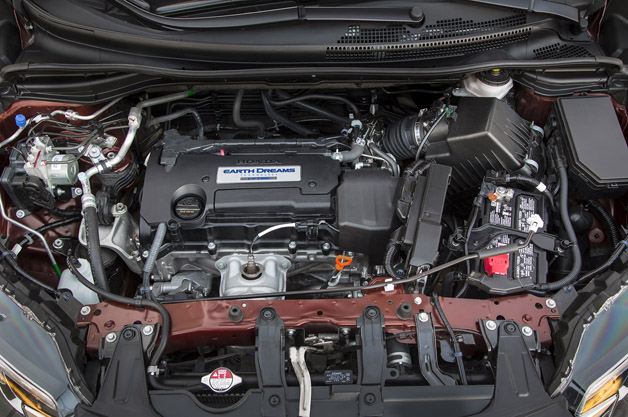
The new engine and transmission pairing has done very good things for the compact CR-V in terms of fuel efficiency.
The new engine and transmission pairing has done very good things for
the compact CR-V in terms of fuel efficiency, meaning the 2015 model
jumps a few points in both its city and highway ratings (FWD EPA rating
is 27 miles per gallon city and 34 mpg highway, while the AWD EPA rating
is 26 highway and 33 highway – on regular unleaded fuel). Owners – and
Honda salespeople – should be pleased, as those figures launch it
comfortably ahead of most of the competition.
Honda is offering ten different versions of the CR-V divided among
five trim levels (LX, EX, EX-L, EX-L Nav and Touring) with FWD or AWD
offered on each. To ensure its continuing competitiveness, all trims
have been upgraded with even more standard equipment, but with minimal
pricing increases. Those familiar with the brand will note the CR-V’s
new Touring trim. It connotes Honda’s top-of-the-line offering, which
adds the most aggressive wheel/tire package and the most comprehensive
suite of electronics and safety equipment.
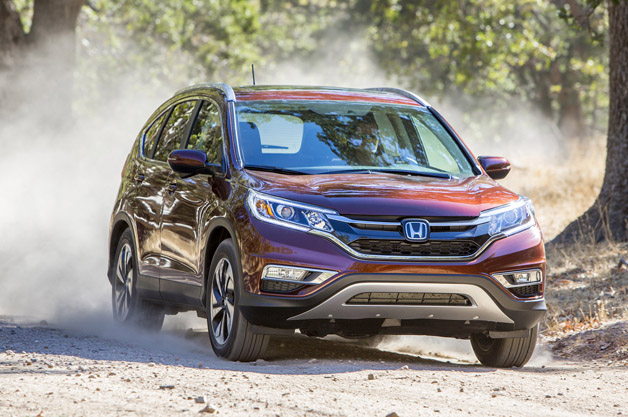
The mannerisms of its front MacPherson strut and rear multi-link suspension are more predictable than the phases of the moon.
The 2015 Honda CR-V’s driving dynamics aren’t going to surprise
anyone – the mannerisms of its front MacPherson strut and rear
multi-link suspension are more predictable than the phases of the moon.
The new Motion-Adaptive Electric Power Steering (EPS) system works well,
too, with decent feedback and confidence-inspiring responsiveness. The
all-wheel-drive system sends nearly all of the power forward unless the
wheels slip, meaning the nose-heavy FWD and AWD models handle and drive
nearly identically.
Our all-wheel-drive model didn’t throw us any surprises, whether in
stop-and-go traffic, cruising at freeway speeds or being tossed into
corners. The vehicle’s Achilles’ heel is the all-season tires
(225/60R18), which lose grip and force expected understeer. Eventually,
the automaker’s standard Vehicle Stability Assist (VSA) jumps in to save
the day. Interestingly, VSA will also provide a limited-slip
differential effect by applying braking force to a spinning wheel,
thereby sending the power across the axle.
Stopping the 3,624-pound CR-V is drama-free, thanks to disc brakes at
all four corners. The somewhat heavier – about 120 pounds – AWD models
wear slightly large rotors. For 2015, Honda’s engineers have increased
the servo ratio on the brake booster to decrease the pedal effort by six
percent and provide a more solid feel underfoot. We were unable to feel
a difference in the brakes, but the pedal effort was good during our
urban driving and a few simulated panic stops were straight. The CR-V
can tow a modest 1,500 pounds when properly equipped.
Opt for the Touring model, and it comes loaded with the automaker’s
Honda Sensing suite of safety and driver-assist features. These include
Forward Collision Warning (FCW) for vehicles and pedestrians, Collision
Mitigation Braking System (CMBS), Adaptive Cruise Control (ACC), Lane
Keeping Assist (LKAS) and Honda LaneWatch. The ACC works well on the
highway, but it is not a full-range system, meaning it won’t work in
stop-and-go traffic (
Acura
offers a more sophisticated version on its vehicles called Adaptive
Cruise Control with Low-Speed Follow). The CMBS will utilize all of the
vehicle’s braking capability, including ABS, in an attempt to slow or
stop the CR-V if it senses an impending collision.
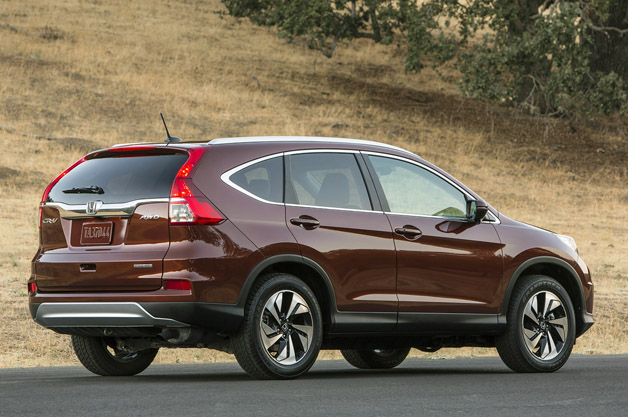
Enhanced driving
comfort, increased utility, improved efficiency and elevated safety are
exactly what crossover shoppers in this segment are seeking.
Thankfully, we didn’t have occasion to really test any of the safety
systems, but we did use Honda’s Lane Watch system countless times. The
camera-based technology, which provides an 80-degree view of the
passenger-side of the vehicle to help uncover the blind spot using the
navigation screen, is offered for the first time on the CR-V (it’s
standard on EX trim levels and above). It takes a few lane changes to
become comfortable with the system, but then its use becomes completely
natural and helpful – it’s a technology this author would like to see
across the industry.
The first-generation Honda CR-V needed only endearing charm and an
attractive sticker price to move itself out of showrooms – the bar, set
by the
Toyota RAV4,
Suzuki
Sidekick and its Geo Tracker twin, was quite low. But fierce
competition in the mushrooming compact crossover segment is forcing
every automaker, not just Honda, to shorten product lifecycles and
strive to raise the bar far above anyone’s early expectations. The
process is expensive, but increasingly necessary to stay at the head of
the pack.
We really like what Honda has done with its compact crossover. It may
not be particularly daring or innovative, but methodical market
research combined with fanatical communication with current CR-V owners
has focused the automaker’s energy on improving the product to suit its
family-friendly audience. The 2015 Honda CR-V won’t release the
automotive enthusiast buried within anyone, but it will enhance driving
comfort, increase utility, improve efficiency and elevate safety – and
that’s exactly what crossover shoppers in this segment are seeking.
 Chief
Medical Director of the hospital Dr Benjamin Ohiaeri (middle) Dr Adaora
Igonoh (2nd left), Dr Ibeawuchi Morris (3rd left) Dr Fadipe Akinniyi
(2nd right) who got infected but got healed.
Chief
Medical Director of the hospital Dr Benjamin Ohiaeri (middle) Dr Adaora
Igonoh (2nd left), Dr Ibeawuchi Morris (3rd left) Dr Fadipe Akinniyi
(2nd right) who got infected but got healed.






